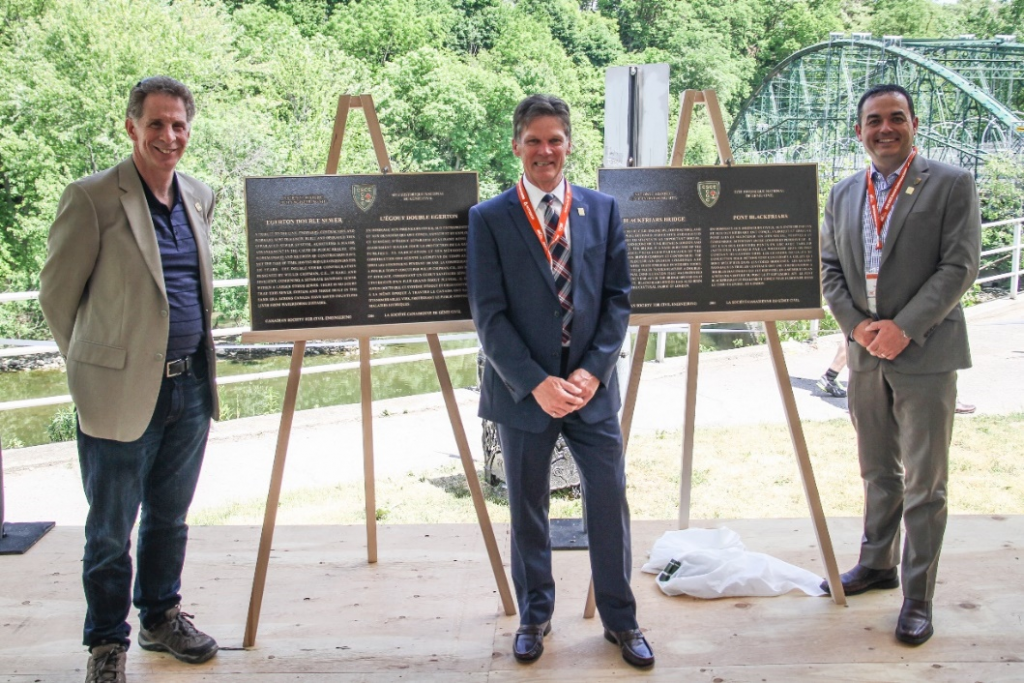

Site Location: Lat.: 42°-58’-50” N; Long.: 81°-12’-44” W. (GPS: 42.9796546, -81.2154436). In central London East, in front of Trafalgar Public School, 919 Trafalgar Street. Take Exit 189 from Highway 401 and follow Highbury Avenue north 5.1 km to Hamilton Road. Turn left (west) on Hamilton Road and, 1.6 km later, turn left (south) on Trafalgar Street and immediately left (east) again to stay on Trafalgar Street. The site is on your right, on the south side of Trafalgar Street. Limited parking is available on side streets in the neighborhood. Also accessible using the London Transit #5 bus.
Plaque Location: On a concrete pedestal in a small park in front of Trafalgar Public School.

Description: In the mid-19th century, poor sanitation in London caused many cases of typhoid: the Thames River was the city's unofficial sewer. Despite local opinion that “The natural place for the sewage of any city is a river, God Almighty gave us rivers to drain the country”, the London Board of Health decided in 1896 to begin construction of intercepter sewers to direct sewage to a new filter farm. They subsequently engaged Willis Chipman to design the 2560 m (7400 ft) Egerton Street Double Sewer as the backbone of the East End system. The sewer served for 100 years, being replaced in 2016.

Historic Significance: The Egerton Double Sewer is a relatively rare design with the sanitary flow separated from the storm flow in a covered channel. The designation also commemorates the role of Willis Chipman, C.E., a national figure in Canadian civil engineering who contributed to the design and construction of waterworks and sewerage systems in 41 cities across Canada. Chipman was also instrumental in the creation of the Association of Professional Engineers of Ontario, serving as its second president. There is no doubt that this sewer system and those built in the same era across Canada have saved countless lives from waterborne diseases.

Plaque Text: National Historic Civil Engineering Site. EGERTON DOUBLE SEWER. A tribute to the civil engineers, contractors, and workers who designed, built and operated this separated sewer system, achieving a major advancement in the cause of public health. Its workmanship and methods of construction have met the test of time, having served Londoners for 100 years. The double sewer configuration designed by Willis Chipman, C.E., is rare and efficient, combining a separate sanitary sewer within a larger storm sewer. There is no doubt that this sewer system and those built in the same era across Canada have saved countless lives from waterborne diseases. Owner and Operator: City of London. Engineering Firm: Chipman and Power. Canadian Society for Civil Engineering. 2016.
Site historique national de génie civil. L’ÉGOUT DOUBLE EGERTON. En hommage aux ingénieurs civils, aux entrepreneurs et aux ouvriers qui on conçu, construit et exploité ce système d’égout séparatif réalisant ainsi un advancement majeur pour la protection de la santé publique. Sa fabrication et ses méthodes de construction ont resisté à l’épreuve du temps avant servi les Londoniens pendant 100 ans. La configuration à double égout conçue par Willis Chipman, C.E., est rare et efficace, cominant un égout sanitaire séparé à l’entéreur d’un plus grand égout pluvial. Il n’y a aucun doute que ce système d’égout et ceux construits à la même époque à travers le Canada on sauvé d’innombrables vies, protégeant le public contre les maladies hydriques. Propriétaire et Exploitant: City of London. Firme d’ingénierie: Chipman and Power. 2016. La société canadienne de génie civil.
Plaque Unveiling Ceremony: The plaque was unveiled in a ceremony held in a large tent immediately west of Blackfriars Bridge on the afternoon of Friday 03 June 2016. The Master of Ceremonies was Alistair MacKenzie. Tony Bégin, CSCE President, and City Councillor Paul Hubert made brief remarks. John Lucas gave a short description of the history of the sewer and the reasons for its recognition as a CSCE National Historic Site.



Links to Further Documentation:
John V. Lucas, “Egerton Street Double Sewer”, Canadian Civil Engineer, 2016. (See page 12)
Biography of Willis Chipman